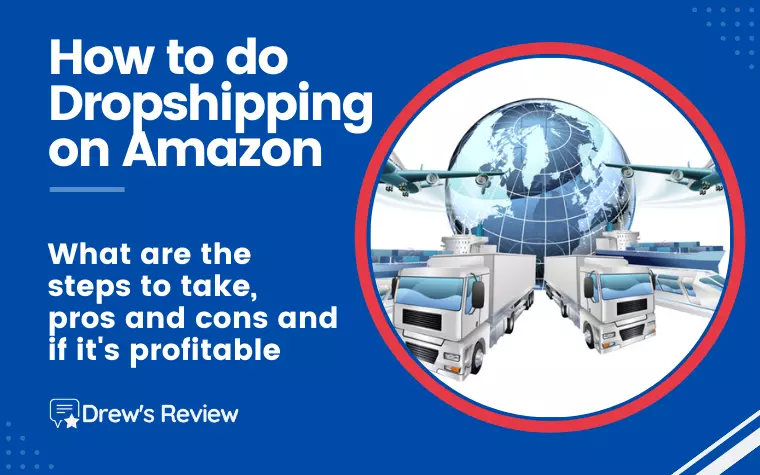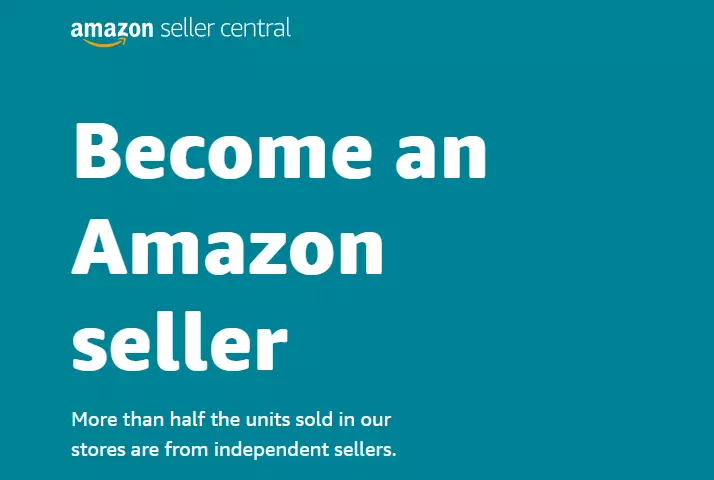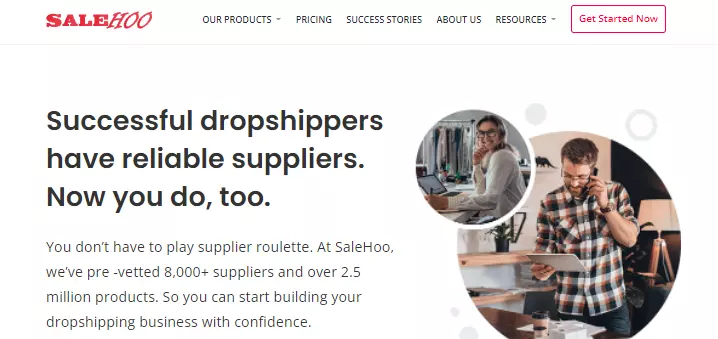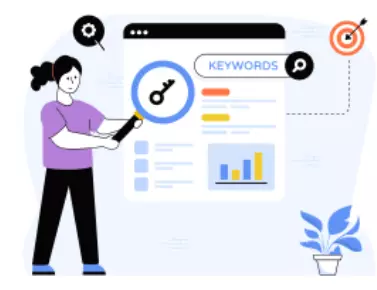
Thinking about dropshipping on Amazon?
It's tempting because Amazon is the world's biggest online retailer and everyone recognizes its name.
Is starting an eCommerce business with Amazon Dropshipping doable? Many new entrepreneurs are looking to do some form or online selling. Is this business model for you?
Dropshipping on Amazon has evolved a lot in recent years. With new seller policies, higher ad competition, and the rise of AI tools like Helium 10’s product analyzer and Amazon’s own generative listings, the landscape is very different from a few years ago.
The good news? It’s still one of the easiest business models to start — if you approach it strategically.
In this updated 2025 guide, I’ll show you exactly what’s changed, what Amazon now expects from dropshippers, and how to build a business that’s sustainable (not just another short-term store).
I’ve tested multiple Amazon and Shopify setups over the years — what follows is based on what still works in 2025.
Let's dive in.
What Is Dropshipping on Amazon?

Dropshipping on Amazon is similar to the typical way of doing dropshipping, except you are doing it on the Amazon marketplace instead of a store hosted on Shopify or some other platform.
Some dropshippers prefer to do it on Amazon because it has such a large customer base. And, of course, because it's Amazon.
It's also much different than Amazon FBA because you aren't holding any inventory yourself.
Is Dropshipping on Amazon Profitable?
The answer to this question is a little complicated because it depends on a lot of factors. The biggest factor is the niche you choose to dropship in.
Some niches are more profitable than others and some have more competition than others. If you can find a niche that is profitable and not too competitive, then dropshipping on Amazon can be quite profitable.
Another factor that will affect your profitability is how well you set up your campaign and how well you optimize it. If you don't do these things well, then your profits will suffer.
But if you do them well, then your profits can be quite good.😊
2025 Profitability Insights
Profitability in 2025 depends more on efficiency and positioning than product price alone.
Margins are thinner (10–20%) due to higher Amazon referral and ad costs.
However, automation tools like AutoDS, Jungle Scout, and AI repricers make scaling easier than ever.
Sellers who build niche authority and maintain excellent seller ratings (95%+) still report consistent profits.
🔹 Tip: Focus on niches with repeat purchases or accessories — they often have better retention and lifetime value than one-time gadget sales.
Does Amazon Allow Dropshipping?
Yes — but you must follow Amazon’s official Dropshipping Policy carefully.
You’re allowed to dropship only if you’re clearly identified as the seller of record. This means:
- Your business name must appear on invoices and packaging.
- You must remove any third-party branding before shipping.
- You handle all customer service and returns.
- You comply with Amazon’s Seller Agreement at all times.
🚫 Avoid “retail arbitrage dropshipping” (buying from Walmart, eBay, etc. to ship to Amazon customers). Amazon bans this practice, and accounts have been suspended for it.
Amazon’s Dropshipping Policy
To sell products on Amazon as a dropshipper you will need to apply and be approved to sell in the category that your products fall under.
There are some categories where Amazon does not allow dropshippers, such as Grocery & Gourmet Food, Health & Personal Care and Beauty.
Amazon has different policies for different countries so it's important that you check the policy for your country before applying to sell.
Familiarize yourself with Amazon's drop shipping policy first.
How Much Does It Cost to Start Dropshipping on Amazon?
Dropshipping fees on Amazon will vary according to product type but typically are between 10 and 15%. If you’re dealing with small margins when doing Amazon dropshipping, this is going to take a pretty big piece out of your profits.
You’re also going to need a selling plan. The individual plan works out to 99¢ for each unit sold. The professional plan is a set monthly rate at $39.99 per month. You can sell unlimited products with this plan.
Realistic 2025 Cost Breakdown
While you can start cheap, a realistic 2025 budget looks like this:
Category Typical Cost Notes Amazon Professional Plan $39.99/month Unlimited listings & analytics access Amazon Referral Fees 10–15% per sale Varies by category Product Samples $50–$200 Always order before listing Product Research Tools $30–$80/month Helium 10, Jungle Scout, etc. Advertising (PPC) $10–$30/day Start small and scale winners Automation Software $20–$50/month Optional but time-saving 💡 Pro tip: Track all fees with a tool like TrueProfit.io — it integrates directly with Seller Central to show your real margins.
Steps on How to Start Amazon Dropshipping
How do you get started selling on Amazon? Here are the steps involved.
1. Set up Your Amazon Seller Account

Before you can start selling on Amazon, you need to set up a seller account. The process is relatively simple and only takes a few minutes.
First, go to Amazon's website and click on "Sell on Amazon." Then, click on "Create your Amazon Seller account now." Next, you will need to enter your email address, create a password, and provide some basic personal information. Once you have completed all of the required fields, click on "Create account."
Be sure to know in advance if you want to set up an individual or professional plan as outlined in the previous step.
2. Do Product Research
When it comes to product research for dropshipping on Amazon, there are a few different avenues you can take.
Start by looking at bestselling items in your niche. Take a look at the product listings and see what features are most important to customers.
You can also look at customer reviews to get an idea of what people like and don’t like about certain products.
Another option is to use Amazon’s search tool to find keywords that are relevant to your products. This will help you determine what people are searching for when they’re looking for products like yours.
You can also utilize third-party tools to help with your research. These tools can provide valuable insights into what products are selling well and how you can improve your own listing.
Stay away from Prime products. These are exclusively sold by Amazon FBA registered sellers so it's going to be difficult to compete with.
When it comes to product research, there is no one-size-fits-all approach. However, by taking the time to explore all of your options, you can ensure that you find the right products for your store.
Having said this, you'll need to get approval for some products. Categories like fashion, music, and jewelry require approval before you can set up your Amazon store.
Familiarize yourself with the overview of categories first.
3. Source a Supplier
This is going to take some legwork, but since there are a lot of suppliers that will drop ship for you, it won't take that much effort.
Here are some ways to find them:
Dropshipping Directories
Dropshipping directories are websites that list suppliers who are willing to work with drop-shippers. This can be a great way to find reliable suppliers, as the directories typically only list companies that have been vetted and approved by the directory’s staff.
In addition, dropshipping directories often offer valuable resources and tips for getting started with dropshipping. Salehoo is an example of a dropshipping directory and has a great reputation. You can find a great third party supplier there.

Search on Google
One of the best ways to find a dropshipper is to do a search on Google. You can start by searching for terms like "dropship suppliers" or "dropship wholesalers."
Once you've found some potential candidates, you can research each one to see if they offer the products you're interested in and if they would be a good fit for your business.
Attend Trade Shows
Trade shows can be a great way to find dropship suppliers for your business. By attending a trade show, you can get an up-close look at the products that potential suppliers have to offer.
You can also talk to representatives from different companies to get a better understanding of their operations.
Trade shows can provide an opportunity to network with other businesses in your industry. Attend a trade show related to your business and you may just find the perfect dropship supplier for your needs.
4. Create an Amazon Product Listing
When selling products on Amazon, one of the most important things Amazon sellers can do is create a product listing that is both accurate and engaging. Fortunately, there are a few simple steps that any seller can follow to create an effective listing.
Go to your Seller Central account first. Then head over to Inventory – Add a Product. At the next screen, click on “Inventory – Add a Product.” At the Add Product screen, click on “Create a New Product Listing.”
First, be sure to include all relevant information about the product, including its title, condition, shipping weight, and dimensions. This will ensure that potential buyers have all of the information they need to make a decision.
Next, write a compelling product description that highlights the features and benefits of the item. Be sure to also include any relevant keywords that potential buyers might use when searching for the product.
Finally, add high-quality photos that show the product from multiple angles. These photos should be clear and bright, and they should highlight any special features of the item. By following these steps, sellers can create Amazon product listings that are both informative and eye-catching.
5: Optimize & Automate
Once your listings are live, the real work begins — optimization and automation.
- Track keyword rankings with tools like Helium 10 or AMZScout. These show you which search terms drive your sales.
- Automate price adjustments using repricing tools to stay competitive 24/7.
- Monitor customer feedback and respond quickly — Amazon’s A-to-Z Guarantee favors sellers who resolve issues fast.
- Refresh listings every few months with updated keywords, fresh photos, or short product videos.
Pro Tip: Amazon loves active sellers. Frequent updates to listings signal reliability and can subtly boost visibility in search.
How Amazon Dropshipping Differs from Shopify Dropshipping
Many people assume the two are the same, but they’re not.
- Shopify = freedom. You own your store, brand, and customer data.
- Amazon = traffic. You get instant access to millions of buyers but have limited control over branding.
- Profit margins: Shopify stores usually keep 30–40%, while Amazon sellers often net closer to 10–20% after fees.
- Customer relationship: Amazon owns it; Shopify lets you build it.
Takeaway: Amazon Dropshipping is great for fast exposure, but consider eventually expanding to Shopify for long-term brand control.
Pros and Cons of Dropshipping on Amazon
There are also several advantages that come with dropshipping on Amazon and they are similar to dropshipping on eBay.
Pros
- Massive built-in traffic – millions of active buyers daily.
- Zero need for inventory or warehouse space.
- Trust factor – customers already trust Amazon’s checkout.
- Easy scaling once you find a winning supplier and niche.
- Access to Amazon FBA later if you choose to hybridize.
Cons
- Profit margins are thinner (10–20%) due to fees + competition.
- Very little control over branding or repeat-customer retention.
- Risk of account suspension if policy rules aren’t followed.
- Increased ad costs (PPC bids have risen ~25% since 2023).
- Difficult to stand out without strong visuals & reviews.
Pro Tip: Think of Amazon as a launchpad, not a permanent home. Use it to validate products, then move proven ones to your own store for higher margins.
Common Mistakes to Avoid (2025)
Even experienced sellers slip up. Here are some pitfalls to watch for:
- Listing Prime-exclusive items — those can only be sold via FBA.
- Using retail suppliers (e.g., Walmart, AliExpress) – Amazon bans retail-arbitrage dropshipping.
- Ignoring customer messages – Amazon tracks response times (under 24 hours is ideal).
- Skipping keyword optimization – AI-driven Amazon search rewards well-optimized listings.
- Neglecting reviews – follow up ethically for reviews; listings with 50+ get roughly twice as many clicks.
Avoid these early on to prevent account warnings or unnecessary losses.
Tips for Success When Dropshipping on Amazon
Now that you understand the mechanics of Amazon dropshipping, here are some tips to help you reach the most success possible.
Promote Your Listing
If you want to succeed on Amazon, it's essential to promote your listing. One way to do this is to invest in pay-per-click advertising. This will help to ensure that your listing appears at the top of the search results, making it more likely to be seen by potential customers.
You can also use social media to generate interest in your listing. By sharing your listing on Facebook, Twitter, and Instagram, you can reach a wider audience and increase the chances of making a sale.
Don't forget to optimize your listing for SEO. This will help to ensure that your listing appears high up in the search results, making it more likely to be seen by potential customers. By following these tips, you can give yourself a better chance of success when dropshipping on Amazon.
Win the Buy Box
The Buy Box is the box on a product listing that allows customers to add the item to their cart. It's prominently displayed, and winning it can give you a significant advantage over your competition.
There are a few things you can do to improve your chances of winning the Buy Box, such as offering competitive prices and maintaining a high level of customer service.
But even if you don't win the Buy Box every time, there are still plenty of sales to be had on Amazon. So don't get discouraged if you don't always come out on top. Just keep working hard and you'll eventually find success.
Be Customer-Focused
One of the most important tips for succeeding with Amazon dropshipping is to focus on the customer. This may seem obvious, but it is often overlooked by sellers who are focused on making a quick profit.

It is important to remember that customers are the reason that Amazon exists, and they should always be the top priority.
Dropshippers who provide good customer service, fast shipping, and quality products will be more successful in the long run than those who do not.
It is important to always be learning and improving. Amazon is constantly changing, and those who are able to adapt will be more successful than those who do not.
Target a 95% Seller Rating
Aim to maintain a rating of 95% or higher, as this will give you the best chance of success. Here are a few tips to help you achieve and maintain a high seller rating:
First, always ship your items on time and provide tracking information to your customers. This will help to ensure that they receive their items in a timely manner and that they can track their shipment.
Second, respond promptly to any customer inquiries or problems. If there is an issue with an order, do whatever you can to make it right.
Finally, take the time to write quality product descriptions and offer competitive prices. The more information you can provide about your products, the better. And, by offering low prices, you'll be more likely to attract buyers and build a loyal customer base.
By following these tips, you can increase your chances of success when dropshipping on Amazon. Remember, aim for a seller rating of 95% or higher and always strive to provide excellent customer service.
Consider Buying Samples of Products you want to Sell
Buying samples of the products you're interested in selling, it helps you in a few different ways.
Offer Better Discounts Than Competitors
Another strategy is to offer a better coupon discount than your competitors. This can help you attract more customers and get them to purchase from you instead of from someone else.
There are a few different ways to go about this.
Whatever approach you take, make sure that your coupons are attractive and easy to find so that customers will be able to take advantage of them.
Do Keyword Research

You need to make sure you do your keyword research thoroughly.
This is one of the most important aspects of successful dropshipping, as it will determine what products you sell and how well your listings rank in Amazon's search results.
There are a number of different tools and methods you can use for keyword research, but the important thing is to take your time and do it properly. Once you have a good selection of keywords, you'll be well on your way to success with your Amazon dropshipping business.
What about Dropshipping with Your Own Online Store?
Dropshipping on Amazon can be fairly lucrative, but you should also consider your own ecommerce store hosted on a platform like Shopify or Woocommerce.
This will give you more control over your brand, product selection, pricing, and the overall customer experience. Plus, it can be a great way to build an asset that you can eventually sell. If you're interested in learning more about setting up your own online store, check out my article on how to start an eCommerce business.
Invest in a Dropshipping Course
If you're not sure how to start a dropshipping business on Shopify, I recommend investing in a dropshipping course. This will give you all the information and resources you need to get started, including how to find suppliers, set up your store, market your products, and more.
Plus, it can be a great way to get started quickly and without a lot of upfront investment. I've put together a list of the best Shopify dropshipping courses here.
Recommended Tools for Amazon Dropshipping
• Product Research – Helium 10
• Automation – AutoDS
• Analytics – TrueProfit.io
• Store Expansion – Shopify
FAQ Section
Q: Can you dropship from AliExpress to Amazon?
No. Amazon bans retail-to-retail fulfillment. You must use verified wholesalers or manufacturers.
Q: Is Amazon FBA better than dropshipping?
They’re different models. FBA is great for established products with consistent demand; dropshipping is lower-risk for testing new items.
Q: Do I need a business license to dropship on Amazon?
It depends on your country. In the U.S. and Canada, yes – you’ll need a business ID and tax number to get approved for seller status.
Q: Can I do both Amazon and Shopify dropshipping?
Absolutely. Many sellers use Amazon to find winning products and Shopify to build a brand around them.
Key Takeaways: Amazon Dropshipping in 2025
- Dropshipping on Amazon still works — but it’s more competitive and policy-driven than ever.
- Start lean with a clear niche, a reliable supplier, and a compliant seller setup.
- Expect margins around 10–20% after fees — profit comes from efficiency, not hype.
- Automate your research, pricing, and emails early to save time and scale faster.
- Use Amazon to test products, but build your own store later for brand control and higher margins.
Bottom line: Success in 2025 isn’t about finding loopholes — it’s about mastering the process and playing the long game.
Conclusion
I hope this article has given you a better understanding of dropshipping on Amazon and how you can be successful with this online business. Amazon dropshipping can be a great way to get started in eCommerce. However, there are also some potential drawbacks that you should now be aware of.
Dropshipping on Amazon still works — but it’s not a get-rich-quick model. Success now comes from strategy, consistency, and customer trust.
Start lean but smart: focus on profitable niches, comply with Amazon’s rules, and use tools that give you an edge.
Here’s your final blueprint:
✅ Do deep product research before listing.
✅ Build a solid relationship with reliable suppliers.
✅ Keep your metrics clean (seller rating 95%+).
✅ Reinvest profits into ads and automation.
✅ Diversify later with your own Shopify store.
Dropshipping on Amazon in 2025 is still profitable — just be ready to adapt as the market evolves. The opportunity is there for those who treat it like a real business.
Related Posts
- 7 Benefits of Cloud ERP Solutions You Shouldn’t Ignore - December 19, 2025
- 7 Tools That Help Organizations Manage Risk and Employee Data - December 18, 2025
- The Importance of Keeping Your Business Finances in Check - December 18, 2025
